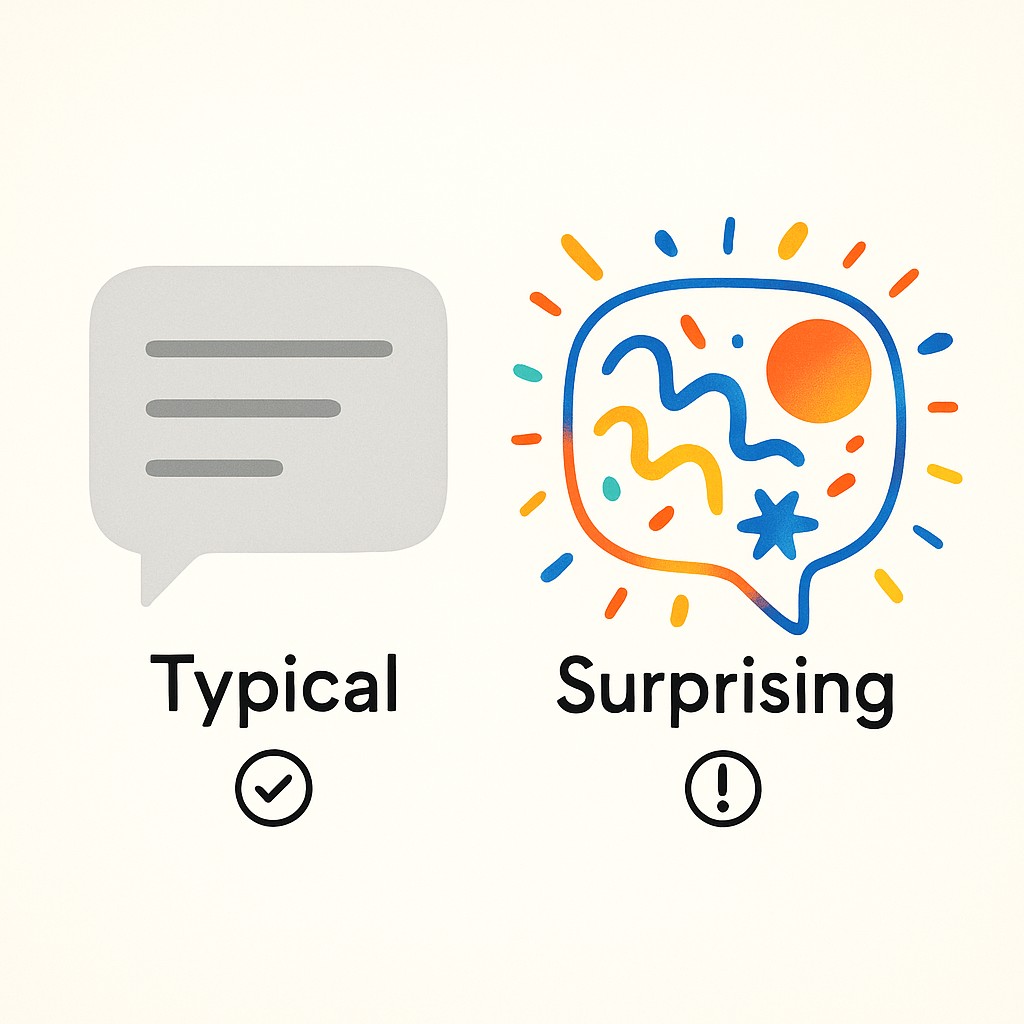Prompt Low-Probability AI Responses for Distinct, Coherent Options
Prompt Low-Probability AI Responses for Distinct, Coherent Options

Why Standard Prompts Get You Safe, Forgettable AI Output
You know the drill. You give a model a prompt like, “AI content isn’t just about efficiency; it’s about unlocking new possibilities.” That output is technically fine, but it’s basically background noise. It’s a sentence you’ve read a dozen times this week, maybe even written yourself. It slides by without making anyone pause.
But ask the same system to stretch by choosing to prompt low-probability AI responses: “AI can write, but it can’t feel. If your post doesn’t contain an opinion, frustration, or desire, it reads like everyone else’s.” Suddenly, the response snaps into focus. It’s sharper. Opinionated. Human. It might even make you a little uncomfortable—at least it’s got a pulse.
Here’s the thing. Nothing else changed except the prompt. Same model, same topic. I just asked it to show me what it was hiding.

For ages, I thought I was fixing bad prompts, rewriting, rewording, fiddling. Really, I was stuck fighting against typicality bias, the model’s learned tendency to shrink its answers toward safe, predictable territory. I spent weeks in that loop, tinkering, thinking I could out-clever the safety net. It wasn’t until I stumbled across a Stanford paper that the gears finally turned. The problem wasn’t creativity. The issue was what the system got rewarded for producing. Suddenly, the “pattern” was obvious everywhere I looked.
So here’s why this matters. The models themselves aren’t boring. They’re just acting that way because that’s what they learned we wanted. If you learn to ask for it, you can pull out riskier, more surprising responses on demand. These sharper outputs make finding new angles faster and help your work stand out. Overcome typicality bias and models stop churning out oatmeal. You get something worth biting into.
Why LLMs Drift Toward the Center—and Why Turning Up Temperature Isn’t Enough
Typicality bias is really just the model’s habit of preferring what it thinks is “safest”—the answers with the highest probability based on its training. RLHF (Reinforcement Learning from Human Feedback) doubles down on this by rewarding completions that feel predictable and easy to endorse. Six months ago, I used to think “creativity mode” was like turning a knob. You just ask for spicy responses. But it’s not that simple. It’s more like changing which completions the model believes are even allowed. When you look beneath the hood, it’s obvious. Most systems are trained to stick close to the answers humans said were fine.
If you’ve ever tried “turning up the temperature” to make outputs less boring, here’s why you still get more of the same. The randomness from temperature works at the token level, letting the model pick less likely words, but only within a tight range. In practice, typicality-based decoding actually narrows choices by restricting words to those with log-probabilities close to the model’s expected entropy at each step. So even when you goose the settings, the model sticks to what it thinks is “normal” one small word at a time.
There’s also the human side—annotators grading outputs, safety teams monitoring edge cases, reward models favoring consistency over surprise. The system keeps getting nudge after nudge to stay bland and predictable. It’s safer for everyone, but it leaves you with answers designed to please the median reviewer, not the creative outlier.
This is mode collapse. The diversity was always there; RLHF just taught the model to hide it. So the researchers introduced Verbalized Sampling: ask for multiple responses with explicit probabilities below 0.10. That’s the shift.
How to Prompt Low-Probability AI Responses—A Practical Pattern for Distinct Outputs
Here’s the mindset shift. If you want outputs that actually stand out, quit asking the model to “be creative.” Start asking for responses it thinks are less probable. That’s it. As soon as you frame things this way, you’re unlocking options the system already knows but usually keeps hidden.
Probability-aware prompting asks the model to sample low-probability completions, using its sense of likelihood as a filter. Instead of requesting a general “better answer,” you invite the model to generate two, three, or five distinct outputs—but only those it considers rare, each with an estimated response probability below your chosen threshold. You’ll see this called verbalized sampling. It works by having the model tag each output with its own probability estimate, so you can pick the spikier ones at a glance.
In practice, here’s how my team runs this pattern. First, set clear constraints on your task—don’t just say “write a blurb,” but add specifics like audience, tone, purpose. Next, ask for N options (I usually stick with three or five). For each, instruct the model to estimate its own probability and only offer outputs where that number falls below, say, 0.10. Have it tag response blocks so filtering’s easy after the fact.
And—crucially—require the model to run a safety and coherence check on each one, weeding out outputs that are risky or nonsensical. Maximum-likelihood decoding usually delivers outputs that aren’t especially human-like or high quality, which is why lower-probability variants can be so powerful (see Decoding Strategies). For what it’s worth, I don’t crank temperature too high. The magic is in explicitly asking for low-probability options, not in making the system incoherent.
A side note here. The first time I tried this approach, I ended up with three versions of the prompt in my drafts folder—one had a typo that made the whole thing sound like a food review, another one kept fixating on “creativity margins” (not even sure that’s a real term), and the third finally got close to what I wanted. I left the food review one in by accident. Later, a teammate said it was the most interesting version. Go figure—I still haven’t decided if that means I should lean into the accidents or stick to the plan, but it’s a pattern I keep noticing.
Honestly, it reminds me of cooking a classic dish with one “wild card” ingredient—like adding miso to caramel. At first, you’re not sure if it’ll work or just confuse everyone. Sometimes it fails. But sometimes, it’s the best bite all night. That’s what low-probability prompt sampling feels like when you get it right: unexpected, controlled, and surprisingly good.
Heads-up: the model’s self-reported probabilities aren’t calibrated. You’ll notice variance, but they work fine for steering. I treat the estimates as a starting point, then combine them with sampling controls (like temperature and top-k) and post-filtering—if you want more rigor, LLMs can reliably output class distributions and, with tricks like invert softmax, you can post-calibrate their probabilities for more accurate filtering (see Calibrated LLM Outputs). Bottom line, you won’t get perfect probability, but you will get reliably more diverse, sharper outputs. And that’s everything teams need for controlled exploration.
Pragmatic Guardrails for Probability-Aware Prompting
Let’s talk about what really slows teams down when experimenting with probability-aware prompts: time. You think, “If I ask for five versions, I’ll be reviewing all afternoon.” That was my first blocker, too. Turns out, you don’t have to batch everything like a research project. Run small batches in parallel—three to five per cycle. Kick out cheap, fast-first drafts for quick review, then escalate only the promising ones for deeper polish. I set up auto-selection so the top two outputs (based on probability and human scan) go forward.
That keeps the cycle under 10 minutes, even for longer pieces. The framing cuts down the back-and-forth, so you spend less time in “what about this?” loops and more time separating what’s worth building on.
Most people worry these “edge-of-distribution” responses will unravel—ramble, lose track, or just go off the rails. If you constrain style, length, and structure—think bullet points, a one-sentence thesis, and direct evidence for each option—you keep the outputs coherent and easy to scan. Give the model a fence, and it’ll fill the yard, not wander down the block.
Safety and compliance are non-negotiable, especially when you dial up riskier outputs. This doesn’t mean slamming the brakes on everything opinionated. Pre-commit your guardrails: add clear safety bounds in the prompt, run content through a post-generation checker, and block risky classes up front. These steps don’t have to neuter opinion. They just lay out what’s off-limits and why. The model gets sharper, but it doesn’t get reckless. Framing for compliance is like setting your own boundaries at a brainstorming session—the weird ideas still show up, but you only work with what fits the ruleset.
Stakeholders usually want some say—understandable, given the shift. When you present outputs, put a typical baseline next to two spiky, low-probability options. Score each on a ‘spikiness’ scale, let approvers choose or edit. That way, you’re not asking them to throw out safety, just giving them more ground to stand on when moving past average.
If you set up these simple guardrails, the move to probability-aware prompting just grows the pie. You get faster cycles, usable variety, and the kinds of answers that actually move meetings and products forward. That’s what makes the headache of change worthwhile.
How to Bring Probability-Aware Prompting Into Real Workflows
I tested it today. Instead of running the usual “generate headlines” batch, I added a twist—ask for two low-probability variants alongside a fallback typical baseline. Give yourself a timestamp, keep the pilot tight, and just swap them into your ideation flow. Nothing fancy or slow. Proof’s in the speed.
This pattern belongs wherever a sharper angle actually helps—brainstorm sessions, naming new features, first-pass ads, strategic openers, anywhere you need ideas that push past the average. But steer clear in legal reviews, regulated messaging, or factual summaries. Those places reward normal over novelty, and you don’t want a weird edge-case getting through.
What should you actually measure? Selection rate: how often does a low-probability output get picked? Decision speed: does vetting sharper variants clog the workflow or speed it up? Most important, watch for real-world differentiation—do your “risky” headlines pull more clicks, shares, or better usability scores compared to the baseline?
Put probability-aware prompting to work: generate distinctive AI outputs, compare them against a typical baseline, and quickly pick the spiky option that stands out—start creating sharper AI-powered content today.
Here’s what’s changing: you’re not making the model more creative, you’re surfacing good alternatives it already understands but usually suppresses. Once you see it, you can’t unsee it—the best ideas were always locked just out of reach. I still wonder if I should let more accidental “food reviews” slip in, but maybe that’s just the flavor that makes it interesting.
Enjoyed this post? For more insights on engineering leadership, mindful productivity, and navigating the modern workday, follow me on LinkedIn to stay inspired and join the conversation.
